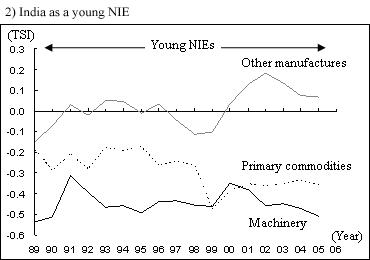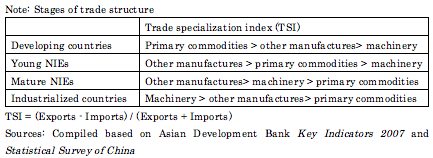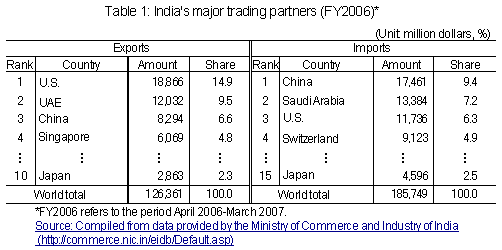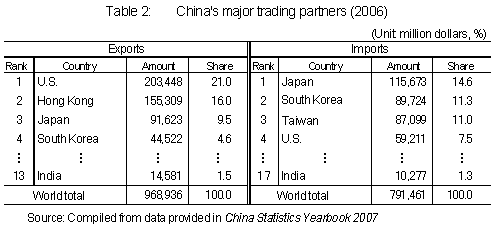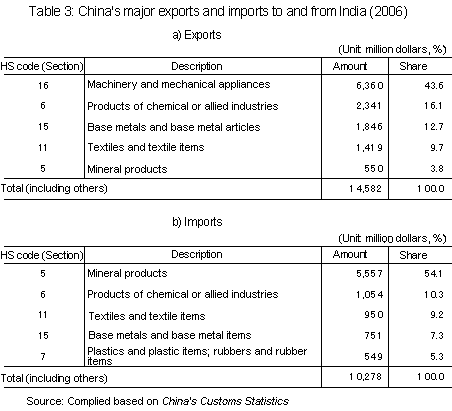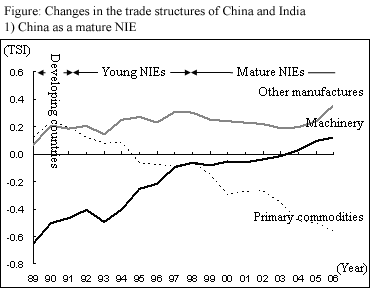In recent years, India has been achieving remarkable growth particularly in the information technology industry. Brazil, Russia, India, and China comprise the BRICs, economies that are attracting global attention. Specifically in Japan, expectations are mounting for India to be an alternative destination to China for investment. Some outside China see India's rise as a threat to China but China itself is seeing it as an opportunity.
India is not a threat to China
Trade between China and India has been rapidly expanding amid continuing high growth and trade liberalization on both sides. China's trade with India multiplied seven times between 2001 and 2006 to reach $24.9 billion, with exports accounting for $14.6 billion and imports for $10.3 billion. Indeed, China's importance to India as a trading partner is increasing. But India, in the eyes of China, does not belong in the league of leading trade partners. In terms of trade value, China is the third largest destination for exports from India, following the United States and the United Arab Emirates, and India receives its greatest amount of imports from China, followed by Saudi Arabia and the U.S. (table 1). In contrast, among China's trading partners India ranks 13th as an export destination and 17th as an import source (table 2).
This asymmetry reflects the fact that China far exceeds India in both total exports and total imports to the world (used as the denominators in calculating the degree of dependence). According to the World Trade Organization, China was the world's third largest trading country in 2006, following only the United States and Germany, with its exports amounting to $969 billion (8.0% of the world's total exports) and imports of $792 billion (6.4%). In contrast, India's exports were $120 billion (1.0% of the world total, ranking 28th) and imports $174 billion (1.4% and 17th).
A comparison focusing on the commodity composition of trade reveals that China's exports consist mainly of industrial products, with the weight of machinery increasing, whereas primary commodities and labor-intensive products such as textiles continue to make up a large portion of India's exports (see Box). This is also clear in the trade between the two countries; machinery comprises a major portion of China's exports to India while mineral products, particularly iron ore, account for more than half of China's imports from India, showing that the weight of primary commodities remains high (table 3). Thus the structure of trade between China and India is complementary to, rather than competing with, each other. Based on this and given that India's share in world trade is far below China's it is quite easy to understand why China does not see India as a threat.
Toward strategic partnership
India is expected to maintain its high growth and increase its presence in the global economy in the coming years. Still, China does not see India as a rival. Rather, it is aiming to form a strategic and cooperative partnership with India. When Premier Wen Jiabao visited India in April 2005, the two countries signed a Five Year Plan for Comprehensive Economic and Trade Cooperation, agreed to launch joint feasibility studies on a China-India free trade agreement (FTA), and set a goal of raising bilateral trade to $20 billion or more by 2008, and $30 billion or more by 2010.
In a speech during his visit in India, Premier Wen made five proposals aimed at expanding economic and trade cooperation between the two countries.
- Expand trade cooperation actively: continue to expand the existing trade in raw materials, steel, electronics, organic chemicals, and machinery equipment while striving to expand into new trade areas.
- Strengthen cooperation in high-tech areas: India is strong in such areas as aerospace technology, information technology, and ocean technology, with its software industry among the global leaders, whereas China has its advantage in areas such as technology, biotechnology, information technology, and particularly in the areas of computer hardware and communications. Both sides will benefit greatly from cooperation in these areas.
- Encourage mutual investment: direct investments in and from each country to the other still remain small but will likely increase in the coming years.
- Promote cooperation in infrastructure projects: India is presently emphasizing the development of infrastructure such as roads, railroads, bridges, ports, and power plants Chinese companies have significant strength in these areas and they have accumulated a wealth of experience in overseas projects China-India cooperation in this area shows great potential.
- Promote multilateral economic and trade cooperation in the WTO and elsewhere.
In November 2006, during President Hu Jintao's visit to India, the China-India Agreement on Bilateral Investment Promotion and Protection was signed and the bilateral trade value target was raised to $40 billion or more by 2010. The two countries have resultantly been making steady progress toward closer economic ties.
Box: China leads India in trade structure
As a country's economy develops, its comparative advantage in international trade gradually shifts from primary commodities to labor-intensive products, and then to capital- and technology-intensive products. This type of development has been observed in a large number of countries' experiences. It follows the "flying geese" pattern of industrial development seen in Japan and many other Asian countries. The pattern can be traced by looking at the changes in the trade specialization indexes of various product categories (TSI - the export-import gap divided by the sum of exports and imports; the higher the index, the greater the international competitiveness of the product category concerned) by major group of trade item (figure). Specifically, based on the relative size of the TSI for each of the three product groups: primary commodities (classified as SITC 0-4), other manufactures (SITC 5, 6, 8, and 9; products other than machinery), and machinery (SITC 7), countries' trade structures can be classified into four types: 1) developing country, 2) young NIE, 3) mature NIE, or 4) industrialized country.
The evolution of China's trade structure can be analyzed using this framework. In the early 1980s, the initial stage after the adoption of the reform and opening-door policy, the trade structure of China was typically that of a developing country; exporting primary commodities and importing machinery. With the progress of the transfer of labor-intensive industries from Hong Kong and Taiwan, China's competitiveness in other manufactures, most visibly in textiles, increased sharply. In 1992, the TSI for other manufactures exceeded that for primary commodities. With this, the trade structure of China shifted from that of a developing country to that of a young NIE. The TSI for machinery began to rise shortly thereafter and, in 1999, exceeded that for primary commodities, and China advanced into the mature NIE stage. In contrast, the trade structure of India has remained in the young NIE stage: the TSI for other manufactures is highest followed by primary commodities and machinery, meaning that India lags behind China by more than 10 years.
